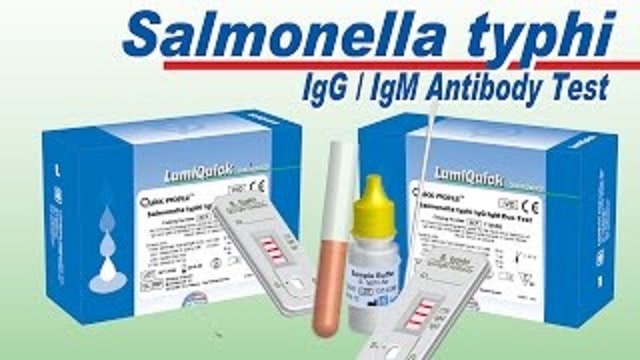Anti-Salmonella Immunoglobulin M Test
Immunoglobulin M Anti-Salmonella check is done to confirm the diagnosis of typhoid fever. Typhoid fever or better known as typhus disease is a health problem that still often occurs in developing countries, especially in tropical areas. In Indonesia itself, the incidence of typhoid fever is an average of 900,0000 cases per year with a death rate of more than 20,000 people, mostly aged 5-19 years.
The cause of typhoid fever is an infection by the bacteria Salmonella typhi which attacks the digestive tract. The disease can be transmitted through human-to-human contact or by consuming food and drinks that have been contaminated with the bacteria Salmonella typhi.
Immunoglobulin M (IgM) Anti-Salmonella check is done to detect IgM antibodies against Salmonella typhi which usually appear 3-4 days after the fever occurs. Usually, this check is done using two different brands of tools. The Tubex TF brand detects IgM Anti Salmonella against antigen 09 S.typhi, while the Typhidot brand detects IgM Anti Salmonella for antigen 50 kDa S.typhi.
The TUBEX test is a serological test that is considered more sensitive, specific, and practical in helping to detect specific antibodies against the antigen components of Salmonella typhi as well as detecting the antigen itself.
The TUBEX test can be rapid (approximately 5 minutes) and highly accurate in diagnosing acute typhoid fever infection because the test only detects the presence of Anti-Salmonella IgM antibodies and does not detect IgG antibodies for several minutes.
Reasons for Performing an Anti-Salmonella Immunoglobulin M Test
Immunoglobulin M Anti-Salmonella Check is a procedure that needs to be done to help diagnose typhoid fever in people who experience symptoms of the disease. Symptoms of typhoid fever can vary from mild to severe. However, symptoms generally appear in the first week, including fever, headache, dizziness, muscle pain, nausea and vomiting, diarrhea, and abdominal discomfort.
Physical examination can only measure the increase in body temperature of the sufferer. Therefore, laboratory tests are needed to help confirm the diagnosis. One of the laboratory tests that can be done to diagnose typhoid fever is the Immunoglobulin M Anti-Salmonella test. By doing this test, the doctor can provide more effective treatment.
When Should You Do an Anti-Salmonella Immunoglobulin M Test?
Immunoglobulin M Anti-Salmonella check should be done immediately after experiencing typhoid fever symptoms. Generally, the incubation period of Salmonella typhi bacteria is 7-14 days, but it can be faster, around three days, or longer, up to 30 days. The incubation period is calculated from when the bacteria enter the body until the initial symptoms appear.
The following are common symptoms of typhoid fever:
- Fever that continues to increase every day until it reaches 39–40 degrees Celsius.
- Feeling unwell.
- Muscle pain.
- Headache.
- Sweating.
- Tiredness and weakness.
- Dry cough.
- Stomach ache.
- No appetite.
- Weight loss.
- In children, typhoid fever can also cause symptoms of diarrhea, while in adults, the disease can cause constipation.
How to Perform Anti-Salmonella Immunoglobulin M Check?
The Immunoglobulin M Anti-Salmonella test requires a blood sample taken from a vein in the arm. In the TUBEX test procedure, 3 milliliters of blood is taken from the patient. The blood sample is then mixed with a blue reagent, which are blue indicator particles coated with monoclonal antibodies (mAb) specific to the Salmonella Typhi antigen. Then, the mixture is placed on magnetic support that is already available to separate the color indicator particles that bind to the magnetic particles from the indicator particles that are not bound.
Then, the TUBEX test result is determined based on the color seen after the mixing reaction. The range of colors that appear can be from red to dark blue. The magnetic support also has a color scale listed as a guide to reading the results.
Scores range from 0–10, where a score of 0 indicates a redder color and a more negative result, while a score of 10 indicates a bluer color and a more positive result. So, a score of 0–2 indicates a negative result, and a score of 3–10 indicates a positive result.
